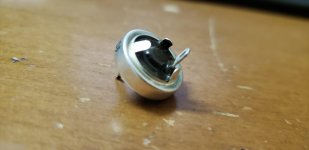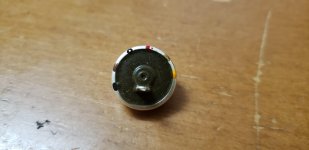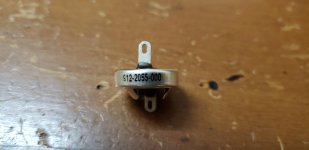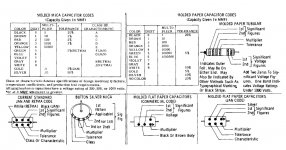Hey!
So I got one of these weird disc things for about $1.
The seller told me that it's a military grade resistor, and it might be one. I used my 20000 count meter on the 20 Ohm range and couldn't get a usable reading as it was close to the resistance of my probe wire and stuff.
There are a few colored dots on it reading black-brown-black-red-gold-yellow(?), but they don't match the resistance of 1 mOhm or something ridiculously low.
I also couldn't get an accurate inductance reading (with a resolution of 100nH), so maybe not an inductor?
It's not a diode either.
There are a few numbers on it but I couldn't find anything.
I have attached the pictures below.
Thanks!



So I got one of these weird disc things for about $1.
The seller told me that it's a military grade resistor, and it might be one. I used my 20000 count meter on the 20 Ohm range and couldn't get a usable reading as it was close to the resistance of my probe wire and stuff.
There are a few colored dots on it reading black-brown-black-red-gold-yellow(?), but they don't match the resistance of 1 mOhm or something ridiculously low.
I also couldn't get an accurate inductance reading (with a resolution of 100nH), so maybe not an inductor?
It's not a diode either.
There are a few numbers on it but I couldn't find anything.
I have attached the pictures below.
Thanks!



My first impression is a feed through cap. Check it as a cap and see. The tabs on the body would be bent down to mount this thing in a hole in a chassis, then the cap part is used to carry a signal through the chassis. Something used in RF, not audio. Of course it could be something totally different too.
COuld conceivably be some sort of semiconductor. Like a varistor or something.
COuld conceivably be some sort of semiconductor. Like a varistor or something.
My first impression is a feed through cap. Check it as a cap and see. The tabs on the body would be bent down to mount this thing in a hole in a chassis, then the cap part is used to carry a signal through the chassis. Something used in RF, not audio. Of course it could be something totally different too.
COuld conceivably be some sort of semiconductor. Like a varistor or something.
It might be a feed through cap as it is shorted across the terminals. Unfortunately, I don't have a capacitor tester. Every tester I've ever had have died.
I doubt that it's a semiconductor though.
Hi.
A quick Google search end up to this.
Buy Now 912-2055-000 from Lintech IS09001:AS9120 Trusted Distributor
Rockwell Collins Inc, CAPACITOR,FIXED,MICA DIELECTRIC
A quick Google search end up to this.
Buy Now 912-2055-000 from Lintech IS09001:AS9120 Trusted Distributor
Rockwell Collins Inc, CAPACITOR,FIXED,MICA DIELECTRIC
- Capacitance Value Per Section
1000.000 picofarads single section - Body Style
w/thd bushing mtg, terminals on opposite end - Case Material
metal - Mounting Facility Type And Quantity
1 threaded bushing - Special Features
0.657 in. dia - Terminal Type And Quantity
2 tab, solder lug - Nonderated Continuous Voltage Rating And Type Per Section
1000.0 dc single section - Tolerance Range Per Section
-10.00/+10.00 percent single section - Temp Coefficient Of Capacitance Range Per Section In Ppm Per Deg Celsius
-20.0/+100.0 single section - Schematic Diagram Designator
no common or grounded electrode(s) - Body Length
0.178 inches nominal
It should charge real quick as it is likely a small value.
Did it on the 20MOhm range and I didn't get any reading.
Hi.
A quick Google search end up to this.
Buy Now 912-2055-000 from Lintech IS09001:AS9120 Trusted Distributor
Rockwell Collins Inc, CAPACITOR,FIXED,MICA DIELECTRIC
- Capacitance Value Per Section
1000.000 picofarads single section- Body Style
w/thd bushing mtg, terminals on opposite end- Case Material
metal- Mounting Facility Type And Quantity
1 threaded bushing- Special Features
0.657 in. dia- Terminal Type And Quantity
2 tab, solder lug- Nonderated Continuous Voltage Rating And Type Per Section
1000.0 dc single section- Tolerance Range Per Section
-10.00/+10.00 percent single section- Temp Coefficient Of Capacitance Range Per Section In Ppm Per Deg Celsius
-20.0/+100.0 single section- Schematic Diagram Designator
no common or grounded electrode(s)- Body Length
0.178 inches nominal
This might be the one. I measured it with a ruler and the body length is around 0.17 inches.
Do you think I should try to charge it to 360V and make sure it's a capacitor?
Do you have any friends with a meter that measures caps? Maybe they would measure it for you, or lend you the meter.
Do you have any friends with a meter that measures caps? Maybe they would measure it for you, or lend you the meter.
Unfortunately, no.
I have an Arduino and I'll try to make a capacitance meter with it and test it with that. Might take a few days, but I'll post the results as soon as they're ready.
It should charge real quick as it is likely a small value.
A few nF is standard for RF feed-thru's, that's like a dead short at VHF.
It seems to be a standard silver mica button capacitor from the '50.
I think it is. I tested it with an ultra crude capacitor tester (multimeter in diode test mode connected in series with a 5mm green LED) and it charges up quickly and holds the charge and I can touch the leads and the body to discharge it.
Using the table you just gave, it comes out as a 1nF cap?
Yes, 1nF 1000V is common for this capacitor style. It is mostly useful for radio frequency applications. If it has been stored properly, it is a good capacitor despite the age; they are sold at 0.50 - 1 euro each at hamfests. It is not very practical in a audio circuit. Maybe it can be used on the output tube anode, on some amplifiers.
Yes, 1nF 1000V is common for this capacitor style. It is mostly useful for radio frequency applications. If it has been stored properly, it is a good capacitor despite the age; they are sold at 0.50 - 1 euro each at hamfests. It is not very practical in a audio circuit. Maybe it can be used on the output tube anode, on some amplifiers.
The seller had 50 of them in sealed foam packaging in an acrylic cover. I might get a few for a bit cheaper for use in maybe timing circuits and for decoupling.
Mica caps are pretty stable (not as NP0, but they have higher voltage ratings).
- Home
- Design & Build
- Parts
- Help Me Identify This Part
